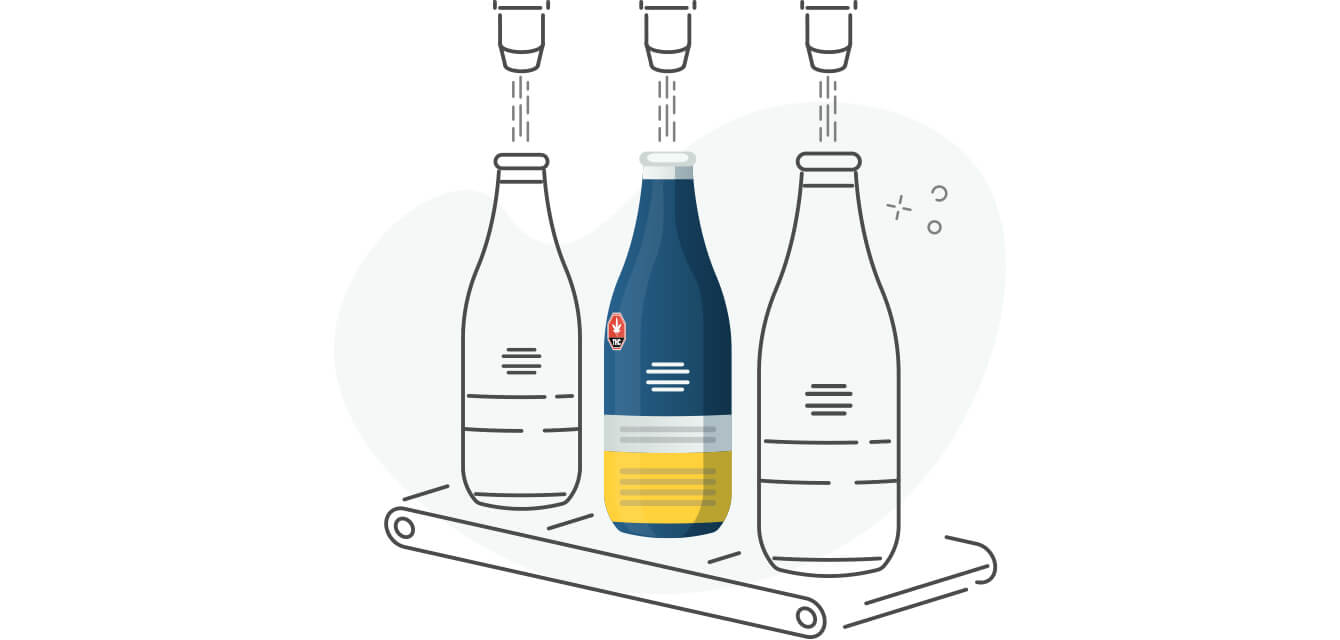How It’s Made
How Cannabis Beverages Are Made
Find out how a scientific discovery helped put cannabis in a beverage and created a whole new delicious batch of products to explore.

Excited to have your choice of cannabis-infused beverages as an alternative to your usual offerings? Thank science. Cannabis beverages have come a long way in a short time, especially now that Licensed Producers have found better methods for infusing cannabis oils into liquids. Let’s look at the science in action as we follow Truss Beverage Co.’s House of Terpenes Sparkling Tonics through the production process.
Step 1: Emulsification

Like many other Licensed Producers, Truss starts with cannabis distillate to make its beverages, one that’s a blend of different strains and can vary slightly from batch to batch.
Cannabis distillate is an oil — and as you know from chemistry class, oil and water don’t mix. So Truss relies on a process called nanoemulsion, which separates the distillate into very tiny spheres (so tiny that 10 of them can fit into the width of a human hair!) that uniformly blend into liquid. These spheres are also more bioavailable, meaning that when you ingest them, the onset of effects will likely be faster than with most other edibles. This game-changing technology has opened the lid on all kinds of new cannabis beverages.
What Is Distillate?
An extremely concentrated form of cannabis oil, distillate is produced from the cannabis plant using a process of boiling and condensation. Read more here.
Step 2: Mixing in the Flavour

Next comes the tasty part: The cannabis emulsion and flavours are stirred together. Producers research consumer preferences and experiment to produce delicious new tastes.
The process of making cannabis extract can strip out most of the plant’s flavourful terpenes. And while some companies use this as a “clean slate” to introduce whatever taste they fancy, Truss created its House of Terpenes line to celebrate and complement cannabis terpene flavours. To do so, they add botanical terpenes, such as those in hops, thyme, orange peel and cloves, back into the mix to create Limonene & Sparkling Tonic and Myrcene & Sparkling Tonic.

“We worked with a team of terpene experts and tasted a range of isolated terpene flavours to better understand what each one tasted like,” says a spokesperson for the brand. “We also looked at what the most popular terpene flavours with consumers were, which led us to select limonene and myrcene. These two flavours are very different from each other — limonene is citrusy and herbaceous, whereas myrcene is more earthy and botanical — but both are a great introduction to the complex world of terpenes.”
Did You Know?
Cannabis terpenes are the same as terpenes found in other botanicals. These fragrant oils produce the unique tastes and smells of each plant, fruit and vegetable.
Step 3: Testing Times Five

Testing is an important step, to ensure not only that the product tastes great but also that it’s responsibly produced. The THC and CBD content must match the amounts listed on the label so consumers know how much they’re consuming. Truss tests its products five times throughout the production process, starting with the ingredients and along to the final product.
Did You Know?
Unlike non-infused beverage companies, licensed cannabis producers such as Truss require a special research licence from Health Canada that permits them to sample the products for taste, aroma, texture and mouthfeel throughout the production process. A big benefit of having the licence is that the products can be sampled after the cannabis is added — ensuring the beverages taste the way they’re meant to.
Step 4: Bottling & Shipping

After the recipe is blended, it’s sometimes carbonated to add sparkle. Then the completed beverage is poured into cans, or glass or plastic bottles. House of Terpenes products are packed in 355 mL recyclable glass bottles, which in a year’s worth of production, hold enough liquid to fill 10 Olympic-sized swimming pools. The finished product, containing all the necessary labelling, is then ready for customers across the country.
Did You Know?
All cannabis products must ensure adherence to federal labelling and packaging requirements , which include the cannabis symbol, brand name, THC and CBD content, health warning message, lot number, “packaged on” date, bar code, nutrition facts table and list of ingredients. It’s a lot to cram on a label but so important for the customer to know. The excise stamp must also be present to show the product is certified legal and the manufacturer has paid the duty on it.
Now that the problem of infusing cannabis in water has been solved, what’s next for the future of cannabis beverages? As the Canadian cannabis market continues to evolve, expect to see more of your favourite flavours. We’ll cheers to that!







